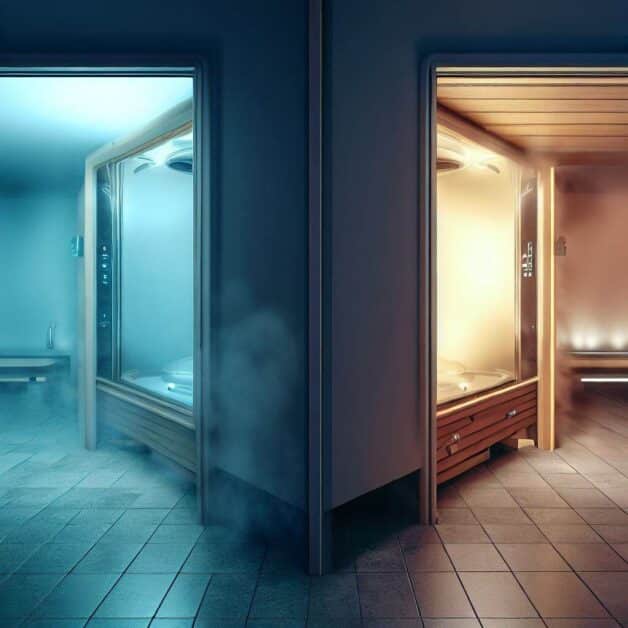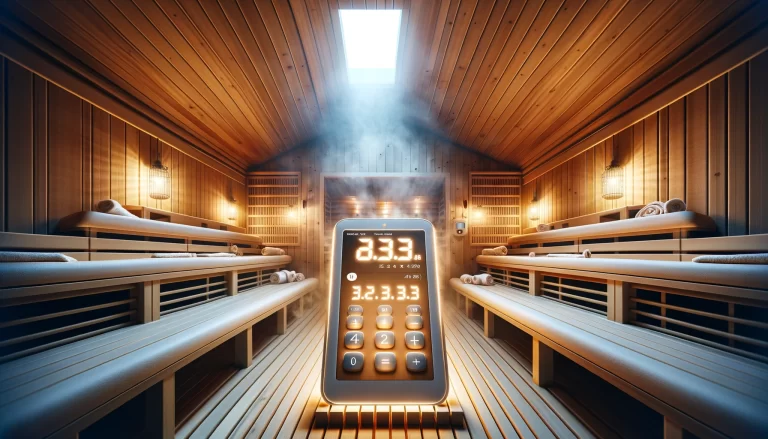Sauna vs Steam Room: Which One Burns More Calories and Fat?
If you want to relax and unwind after a long day, consider visiting a sauna vs steam room. Both of these facilities offer a range of health benefits, including reducing stress, improving blood circulation, easing muscle pain, and enhancing skin health. But did you know that they can also help you burn calories and fat?
In this article, we will compare the effects of a sauna and steam room on your metabolism, calorie expenditure, and fat loss. We will also discuss the pros and cons of each option and how to use them safely and effectively.
What is a sauna, and how does it work?
A sauna is a room heated by dry heat, usually from hot rocks or a stove. The temperature in a sauna can range from 150°F to 195°F, with a low humidity level of around 10%. When you enter a sauna, your body temperature rises, causing you to sweat profusely. This process helps your body to flush out toxins, relax your muscles, and dilate your blood vessels.
According to the North American Sauna Society, a traditional Finnish sauna session consists of several heating and cooling cycles. Each cycle lasts about 10 to 20 minutes, followed by a rest outside the sauna. You can also sprinkle water on the hot rocks to create steam and increase humidity.
What is a steam room, and how does it work?
A steam room is a room that is heated by steam from boiling water. The temperature in a steam room is usually between 110°F and 120°F, with a high humidity level of 100%. When you enter a steam room, you are surrounded by moist and warm air, which makes you sweat and breathe deeply. This process helps your body to hydrate your skin, clear your sinuses, and loosen your joints.
According to Healthline, a typical steam room session lasts about 15 minutes. Adding some essential oils or herbs to the steam generator creates aromatherapy benefits.

How do sauna vs steam room affect your metabolism?
Metabolism is the process by which your body converts food into energy. It consists of two components: basal metabolic rate (BMR) and thermic effect of food (TEF). BMR is the number of calories your body burns at rest, while TEF is the number of calories your body burns during digestion.
Both saunas and steam rooms can increase your metabolism by raising your body temperature and heart rate. According to Verywell Fit, this effect is similar to moderate exercise. However, the increase in metabolism is only temporary and lasts for a short time after you leave the sauna or steam room.
How do saunas and steam rooms affect your calorie expenditure?
Calorie expenditure is the amount of calories your body burns during physical activity. It depends on several factors, such as your weight, age, gender, intensity, duration, and type of activity.
Both sauna and steam room can increase your calorie expenditure by making you sweat more. According to Livestrong, you can burn about 300 calories in 30 minutes in a sauna or steam room. However, this number may vary depending on your characteristics and conditions.
It is important to note that most weight loss in a sauna or steam room is due to water loss, not fat loss. This means you will regain weight as soon as you rehydrate yourself. Therefore, saunas and steam rooms should not be used as a substitute for exercise or a healthy diet.
Comparison Table
| Sauna | Steam Room |
|---|---|
| Heated by dry heat, usually from hot rocks or a stove | Heated by steam from boiling water |
| Temperature ranges from 150°F to 195°F, with low humidity of around 10% | Temperature ranges from 110°F to 120°F, with high humidity of 100% |
| More effective for detoxification and relaxation | More effective for skin moisturizing and congestion clearing |
| More suitable for people with respiratory problems or allergies | More suitable for people with dry skin or nasal issues |
| More likely to cause dehydration and overheating | More likely to cause bacterial growth and mold formation |
| More risky for people with cardiovascular problems or high blood pressure | Less risky for people with cardiovascular problems or high blood pressure |
How do saunas and steam rooms affect your fat loss?
Fat loss is the reduction of body fat percentage. It is different from weight loss, which can include loss of muscle mass, water weight, or bone density. Fat loss requires creating a calorie deficit, which means burning more calories than you consume.
Both sauna and steam room can indirectly affect your fat loss by improving your overall health and well-being. According to Medical News Today, some of the benefits of sauna and steam room include:
- Reducing stress hormones such as cortisol, which can promote fat storage
- Improving insulin sensitivity, which can regulate blood sugar levels and prevent fat accumulation
- Enhancing growth hormone production, which can stimulate muscle growth and fat burning
- Boosting immune system function, which can prevent infections and inflammation that can impair fat loss
- Promoting recovery and repair of muscles and tissues, which can increase energy expenditure and fat oxidation
However, a sauna and steam room alone can cause significant fat loss with proper exercise and nutrition. They should be used as an adjunct to a balanced lifestyle that includes regular physical activity, adequate hydration, sufficient sleep, and a nutritious diet.
Which one is better for you: the sauna or the steam room?
The answer to this question depends on your personal preference, goals, and health conditions. Both sauna and steam rooms have advantages and disadvantages, and you should consult your doctor before using either, especially if you have any medical issues or concerns.
Some of the pros and cons of sauna and steam room are:
Sauna
Pros:
- More effective for detoxification and relaxation
- More suitable for people with respiratory problems or allergies
- more comfortable for people who do not like humidity or moisture
- More effective for detoxification and relaxation
- More suitable for people with respiratory problems or allergies
- more comfortable for people who do not like humidity or moisture
Cons:
- More likely to cause dehydration and overheating
- Riskier for people with cardiovascular problems or high blood pressure
- Less beneficial for skin hydration and sinus relief
- More likely to cause dehydration and overheating
- Riskier for people with cardiovascular problems or high blood pressure
- Less beneficial for skin hydration and sinus relief
- Pros:
- More effective for detoxification and relaxation
- More suitable for people with respiratory problems or allergies
- more comfortable for people who do not like humidity or moisture
- More effective for detoxification and relaxation
- More suitable for people with respiratory problems or allergies
- more comfortable for people who do not like humidity or moisture
- Cons:
- More likely to cause dehydration and overheating
- Riskier for people with cardiovascular problems or high blood pressure
- Less beneficial for skin hydration and sinus relief
- More likely to cause dehydration and overheating
- Riskier for people with cardiovascular problems or high blood pressure
- Less beneficial for skin hydration and sinus relief
Steam room
- Pros:
- More effective for skin moisturising and congestion clearing
- More suitable for people with dry skin or nasal issues
- more comfortable for people who like humidity or moisture
- More effective for skin moisturising and congestion clearing
- More suitable for people with dry skin or nasal issues
- more comfortable for people who like humidity or moisture
Cons:
- Less effective for toxin elimination and muscle relaxation.
- Less suitable for people with fungal infections or asthma.
- More likely to cause bacterial growth and mould formation.
- Less effective for toxin elimination and muscle relaxation.
- Less suitable for people with fungal infections or asthma.
- More likely to cause bacterial growth and mould formation.
Pros:
- More effective for skin moisturising and congestion clearing.
- More suitable for people with dry skin or nasal issues.
- more comfortable for people who like humidity or moisture.
- More effective for skin moisturising and congestion clearing.
- More suitable for people with dry skin or nasal issues.
- more comfortable for people who like humidity or moisture.
Cons:
- Less effective for toxin elimination and muscle relaxation.
- Less suitable for people with fungal infections or asthma.
- More likely to cause bacterial growth and mould formation.
- Less effective for toxin elimination and muscle relaxation
- Less suitable for people with fungal infections or asthma.
- More likely to cause bacterial growth and mould formation.
How to use it safely and effectively?
You should follow some general guidelines and precautions to get the most out of your sauna or steam room experience. Here are some tips to help you use sauna and steam room safely and effectively:
- Drink plenty of water before, during, and after your session to prevent dehydration and electrolyte imbalance
- Wear loose-fitting, breathable, and light-coloured clothing or a towel to avoid overheating and skin irritation
- Start with shorter sessions of 5 to 10 minutes and gradually increase the duration and frequency as you get used to the heat
- Take breaks between cycles of heating and cooling to allow your body to adjust and recover
- Avoid alcohol, caffeine, nicotine, or drugs that can impair your judgment, blood pressure, or heart rate
- Do not use the sauna or steam room if you are pregnant, sick, injured, or have any medical conditions that can affect your ability to tolerate heat or humidity
- Stop immediately and seek medical attention if you experience any symptoms of heat exhaustion, heat stroke, dehydration, or hypotension, such as dizziness, nausea, headache, fainting, chest pain, or irregular heartbeat
Final Analysis:
A sauna and steam room are great ways to relax and rejuvenate your body and mind. They can also help you burn calories and fat by increasing your metabolism, calorie expenditure, and fat loss.
However, they are not magic solutions that can replace exercise or diet. They should be complementary tools to enhance your overall health and well-being.
Visit For more reading about Healing in Style and more information about Saunas.
Common Queries:
Q: Will I lose fat by sitting in a sauna? A: While saunas can make you sweat and temporarily shed water weight, they do not directly lead to fat loss. For sustainable fat loss, focus on a balanced diet and regular exercise.
Q: How long should I stay in a sauna? A: The duration of a sauna session depends on personal tolerance and the type of sauna. As a general guideline, start with 10 to 15 minutes and gradually increase if comfortable. Remember to stay hydrated and listen to your body.
Q: Can saunas help with muscle recovery? A: Yes, saunas can aid in muscle recovery by promoting relaxation and increased blood flow. However, they should not replace proper rest and recovery techniques.
Q: Are saunas safe during pregnancy? A: Avoiding saunas during pregnancy is best, as excessive heat can harm the developing fetus. Consult with your healthcare provider for personalized advice.
Q: Can children use saunas? A: Saunas are not recommended for young children, as their bodies may have difficulty regulating temperature. It’s safer for them to avoid intense heat environments.
Q: Should I shower before or after a sauna session? A: It’s a good idea to shower before entering a sauna to remove any lotions or oils that could block sweat pores. After the sauna, a cool shower can help cool down the body.
Q: Can saunas help with detoxification? A: Yes, saunas can aid in detoxification by stimulating sweating, which helps remove toxins from the body. However, it’s essential to support detoxification with a healthy lifestyle overall.
Q: How often should I use a sauna? A: The frequency of sauna use depends on individual preferences and tolerance. For most people, 2-3 sauna sessions per week are sufficient. Avoid using saunas daily to prevent overexposure to heat.
Q: Are there any medical conditions that prohibit sauna use? A: Individuals with certain medical conditions, such as heart problems, low blood pressure, or skin conditions, should consult their doctor before using a sauna to ensure it’s safe for them.
Q: Can I exercise in a sauna to boost weight loss? A: Exercising vigorously in a sauna is not recommended, as it can lead to dehydration and other health risks. Stick to light stretching or relaxation during your sauna session.














2 Comments